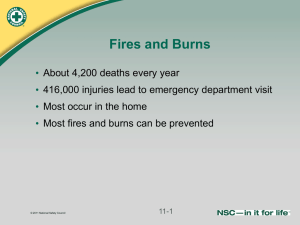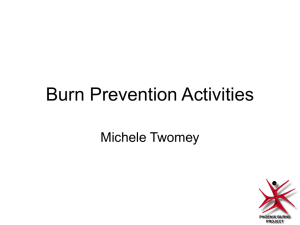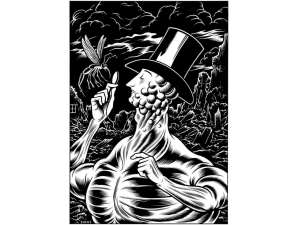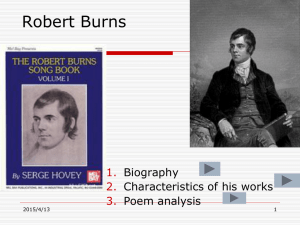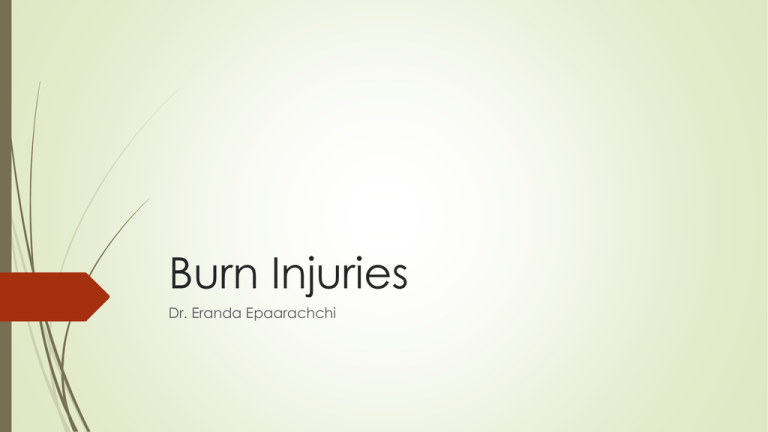
Burn Injuries
Dr. Eranda Epaarachchi
The layers of the skin
Anatomy of the skin
Classification of burns –
By depth
What is shown here?
What is the diagnosis?
First degree burns
Characteristics
Epidermis is involved
Appearance
: Redness (Erythema)
Dry & painful
Heals within 1 week
Complications : Risk of developing skin cancer in later
life
What are these lesions?
Superficial – partial thickness burn (20)
Second degree – Partial thickness
Characteristics
Extends into superficial dermis
Red with clear blister & Blanches with pressure
Moist & painful
Heals within 2-3 weeks
Complications
: Local infection, Cellulitis
What are these lesions?
What are these lesions?
Deep partial thickness burn
Characteristics
Extends into deep dermis
Red-and-white with bloody blisters & Less blanching
Moist & painful
May heal in weeks or progress into a third degree burn
Complications
: Scarring, contractures (May need skin grafts)
What are these lesions?
Third degree burns (Full thickness)
Characteristics
Extends through entire dermis
Stiff and white/brown
Dry, leathery to touch
Painless
Requires excision
Complications
: Scarring, contractures, amputation
What are these lesions?
It’s a fourth degree burn
Characteristics
Extends through skin, subcutaneous tissue and into underlying muscle and
bone
Black (charred)
Dry
Painless
Requires excision
Complications : Amputation, significant functional impairment, possible
gangrene, and in some cases death
Classification of burns by
causes
Chemical
Most chemicals that cause burns are strong acids & bases
Acids
: H2SO4, HNO3, HCl
Bases
: NaOH
Acid burns
: Most of the injury occurs at the point of impact
Alkali burns
: Capable of deep penetration and can cause severe pain
NaOH burn after 44 hours from
exposure
Electrical burns – Causes
1. Workplace injuries
2. Taser wounds
3. Being defibrillated
without a conductive
gel
4. Lightning
Electrical burns
Human body is very vulnerable to application of supra-physiologic
electric fields
Some electrocutions produce no external burns at all, as very little
current is required to cause fibrillation of the heart muscle
The internal injuries sustained may be disproportionate to the size of
the burns seen (if any), and the extent of the damage is not always
obvious
Such injuries may lead to
Cardiac arrhythmias
Cardiac arrest
Unexpected falls with resultant fractures or dislocations
Electrical burns – Low voltage injuries
Low-voltage (<500 AC volts) injuries usually doesn’t have
skin burns
This is sufficient to cause cardiac arrest and ventricular
fibrillation
VF (Can lead to aystole in minutes) –
Defibrillation to save the life
Electrical burns – High voltage
(> 1000V) injuries
Common cause of third and fourth degree burns
Explosions caused by electrical faults produce high
intensity Ultraviolet radiation which can also cause
radiation burns
Radiation burn – causes
Radiation burns are caused by prolonged exposure to
UV light (Sun exposure – the commonest) : Severity UVB > UVA
Tanning booths
Radiation therapy
Radioactive fallout
X-rays
More severe cases of sun burn result in what is known as
"heatstroke“
Microwave burns are caused by the thermal effects of microwave
radiation
Heatstroke
Microwave burn
Scalding
Caused by hot liquids (water or oil) or gases (steam)
Immersion scald is created when an extremity is held under the surface of
hot water (Common form of burn seen in child abuse)
Scald burns are more common in children
Generally scald burns are first or second degree burns, but third degree
burns can result, especially with prolonged contact (Diabetic neuropathy)
Scald
Immersion scald
Child abuse?
SSSS
Inhalation injury
Steam, smoke and high temperatures can cause inhalational injury to the
airway and lungs
Inhalation injury
Pathophysiology of burns injuries
Burn injury results in a local or systemic inflammatory response (Depends on
the size of the burn)
The lungs may be doubly compromised by smoke inhalation
Following a major burn injury, heart rate and peripheral vascular resistance
increase
This is due to the release of catecholamines from injured tissues and the
relative hypovolemia that occurs from fluid volume shifts
Pathophysiology of burns injuries
Initially cardiac output decreases
At approximately 24 hours after burn injuries, cardiac output returns
to normal if adequate fluid resuscitation has been given
Following this, cardiac output increases to meet the hypermetabolic needs of the body
Pathophysiology of burns injuries
The effects of high temperature on tissue include speeding
chemical reactions & denaturing proteins
Pathophysiology of burns injuries
Due to the inflammatory response, permeability of blood vessels is
increased in the burn area
This causes exudation of proteins and fluid into the adjacent interstitial
tissue
Red cells are not extravasated
This results in increase in the oncotic pressure in the interstitium
Pathophysiology of burns injuries
The volume of fluid loss is directly proportional to the burn area
If burn area is 10% to 15% of the total body surface area (TBSA), then
the consequent fluid loss may cause circulatory shock
If it is more than 25% of TBSA, then inflammation occurs even in the
blood vessels remote to the burn, causing greater fluid loss
Diagnosis – By severity
By American Burn Association
Major burns – Treat in specialized burn
units
1. Age 10-50yrs
: Partial thickness burns >25% of total body surface area
2. Age <10 or >50
: Partial thickness burns >20% of total body surface area
3. Full thickness burns >10%
4. Burns involving the hands, face, feet or perineum
5. Burns that cross major joints
6. Circumferential burns to any extremity
7. Any burn associated with inhalational injury
8. Electrical burns
9. Burns associated with fractures or other trauma
10. Burns in infants and the elderly
11. Burns in persons at high-risk of developing complications
Moderate burns – Treat in hospitals
1. Age 10-50yrs
: Partial thickness burns involving 15-25% of total
body surface area
2. Age <10 or >50 : Partial thickness burns involving 10-20% of total
body surface area
3. Full thickness burns involving 2-10% of total body surface area
Minor burns – Doesn’t require
hospitalization
1. Age 10-50yrs
surface area
: Partial thickness burns <15% of total body
2. Age <10 or >50 : Partial thickness burns involving <10% of total body
surface area
3. Full thickness burns <2% of total body surface area, without
associated injuries
Estimating surface area burnt – Rule of
9
Lund & Browder charts (More
accurate)
The size of a person's hand print (palm and fingers) is approximately 0.8% of
their TBSA, but for quick estimates, medical personnel round this to 1%,
slightly overestimating the size of the affected area
Burns of >/= 10% in children or >/=15% in adults are potentially life
threatening injuries (because of the risk of hypovolemic shock) and should
have formal fluid resuscitation and monitoring in a burns unit
Lund & Browder charts
Lund & Browder charts
Management
Once the injured person is stabilized, attention is turned to the care
of the burn wound itself
Until then, it is advisable to cover the burn wound with a clean and
dry sheet or dressing
Early cooling reduces burn depth and pain, but care must be taken
as uncontrolled cooling can result in hypothermia
IV fluids
Children with >10% TBSA burns, and adults with >15% TBSA burns need
formal fluid resuscitation and monitoring (blood pressure, pulse rate,
temperature and urine output)
Once the burning process has been stopped, the injured person should be
volume resuscitated according to the Parkland formula
This formula calculates the amount of Ringer's lactate required to be
administered over the first 24 hours post-burn.
Parkaland formula
Composition of Ringer’s
lactate
Hartman’s solution (Very similar, but
ionic concentrations are different)
Na+
= 131
K+
=5
Ca2+
=4
Cl–
= 111
Lactate
= 29
IV fluids
Parkland formula
= 4ml x (percentage of total body-surface-area
sustaining non-superficial burns) x (person's weight in kg)
Half of this total volume should be administered over the first 8 hours, with
the remainder given over the following 16 hours
This time frame is calculated from the time at which the burn is sustained,
and not the time at which fluid resuscitation is begun
IV fluids
Children also require the addition of maintenance fluid volume
The formula is a guide only and infusions must be tailored to the urine
output and central venous pressure
Inadequate fluid resuscitation may cause renal failure and death, but overresuscitation also causes morbidity
Crystalloid fluids appear just as good as colloid fluids and as colloids are
more expensive they are not recommended
Other aspects of the management
Wound care : Biosynthetic dressings may speed healing
Antibiotics
Analgesics
Surgery
: Skin grafts (As early as possible for better results)
Alternative therapy
: Bee honey
Biosynthetic dressing
Complications – Infections
Risk factors for infections
1. Burn > 30% TBSA
2. Full-thickness burn
3. Extremes in age (very young, very old)
4. Preexisting disease e.g. diabetes
5. Virulence and antibiotic resistance of colonizing organism
6. Failed skin graft
7. Improper initial burn wound care
8. Prolonged open burn wound
Complications
Burn wounds are prone to tetanus (A tetanus booster shot is
required if individual has not been immunized within the last 5 years)
Circumferential burns of extremities may compromise circulation.
Elevation of limb may help to prevent dependent edema
Acute Tubular Necrosis of the kidneys can be caused by myoglobin
and hemoglobin released from damaged muscles and red blood
cells
Prognosis
The modified Baux score determines the futility point for major burn injury
The Baux score is determined by adding the size of the burn (% TBSA) to the
age of the patient
In most burn units a score of 140 or greater is a non-survivable injury, and
comfort care should be offered
In children all burn injuries less than 100% TBSA should be considered a
survivable injury.
A major concern of a survivor of any traumatic injury is post-traumatic stress
disorder (PTSD)
Another significant concern for children is coping with a disturbance in
body image



